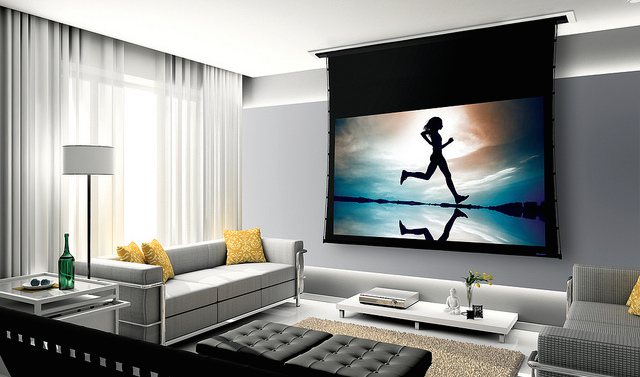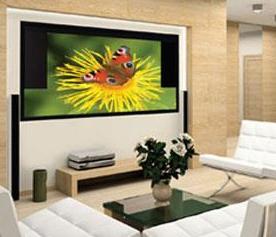
Last time we reviewed what to look for in a media room or home theatre projector, but that is literally only half the picture. Some people may use a white-ish wall or paint a wall with special ‘screen’ paint, but this will have mixed results. To get the full benefit of your projector, you should use a proper screen for your room.
The first thing to decide is screen size and format. Screen size will be a balance of your room dimensions and preference  versus the projector’s capability. The format will be dictated by the content you usually watch. For example, if you watch mostly HDTV (16:9) content, you should get a 16:9 screen. The down side is that other content, e.g. CinemaScope (2.35:1), will not have the screen masked with the black frame properly. Automatic masking systems that adjust for the format are a consideration for folks who watch different formats and are demanding with their viewing experience.
versus the projector’s capability. The format will be dictated by the content you usually watch. For example, if you watch mostly HDTV (16:9) content, you should get a 16:9 screen. The down side is that other content, e.g. CinemaScope (2.35:1), will not have the screen masked with the black frame properly. Automatic masking systems that adjust for the format are a consideration for folks who watch different formats and are demanding with their viewing experience.
The next thing you should settle on is the style of screen. Screens can be fixed frame or roll up (or down). A fixed frame screen is simply a screen stretched on a frame that is permanently on your wall. A roll up screen allows you to roll up your screen when not in use. The screen can roll up into a box that is on your wall or below your ceiling. If you want to get fancier, there are screens that roll up into the ceiling and essentially disappear. These screens can be automatic a la James Bond style too. You can also get screens that come out of the floor (or ground when used in a pool area). Either way, make sure the roll away screen has a quality tensioning system, as a screen that isn’t flat is no fun to watch.
Once you have settled on style of screen, you’ll need to determine which screen surface material works for your space. Surface material is usually advertised in Gain and Half Gain Viewing Angle. Gain is the amount of light that is reflected (1.0 for a white surface). In very general terms, white coloured screens are for a room like a dedicated home theatre where there is no ambient light. Grey coloured screens, like Stewart Filmscreen’s Tiburon, have material that is suited in media type rooms where there’s ambient light. This is where the viewing angle comes into play, as the trade off on material and gain is that brightness and colour changes when you’re off centre to the screen. If you’re big into 3D content, you’ll also need to keep that in mind as well because different material is better suited for 3D viewing. Manufactures use many surface materials to balance gain and viewing angle for various viewing conditions from dark rooms to bright auditoriums, so you have lots of options.
Another option to consider is a perforated screen. Perforated screens allow you to put the speakers behind the screen to allow the sound to come through the screen right from the image. A good perforated screen will not degrade picture quality and will be practically acoustically transparent. Of course, you’ll need to put speakers in the wall or build a special baffle wall to house the speakers.
There are enough options to make your head spin, but this overview should get you started. With a bit of research and understanding of your needs and your room’s specifics, you can narrow down your search quite quickly. From there, you can take the time to ensure proper projector and screen placement to avoid projection path issues and unnecessary adjustments like keystone. Once you’ve put together the right system, you should be set for a thrilling and immersive viewing experience.
